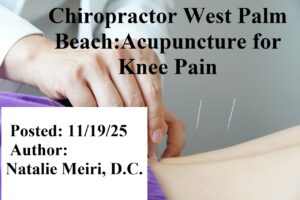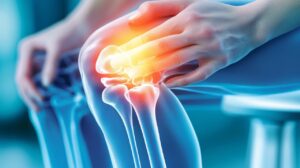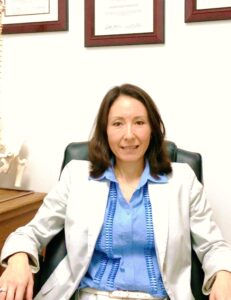
From Dr. Natalie Meiri’s clinical pearl stories- Chiropractor West Palm Beach: Acupuncture for Knee Pain
This is my clinical pearl story about Chiropractor West Palm Beach: Acupuncture for Knee Pain. He was a 56 year old male patient. His chief complaint was right knee pain. To be HIPAA compliant, I will call him Beckett instead of his real name.
Originally, Beckett had come to see me for neck and back problems which he thought were job related. He also had played football in high school and hurt himself. And with chiropractic care, his neck and back problems were so much better. Currently, he came in for supportive/maintenance chiropractic care about once a month for his neck and back.
Beckett’s right knee pain had come on 6 months ago. He didn’t know how it started because there was no trauma. It came on after twisting climbing a ladder. He was an electrician and A.C. technician. So, Beckett did do some heavy lifting on the job which contributed to the repetitive injury to his knee.
Beckett’s Knee Pain
First, Beckett’s right knee pain was a new problem he never had before. Second, the knee pain was located in the medial (inner) aspect of his knee joint. Third, Beckett had started acupuncture for a ear problem with me. And he had a good outcome. Therefore, he thought acupuncture would help his knee pain as well.
Beckett’s Examination
Upon examination, Beckett tested positive for his right knee pain condition. Beckett had strained his knee twisting just as he had described in his history to me. I would order imaging if Beckett didn’t respond to treatment in 1 month.

Some Anatomy of the knee: Femur (thigh bone), Tibia (shin bone), Fibula (thin, outer long bone of the leg), and the Patella (kneecap)
There are three “articulations” (joint or juncture between bones or cartilages) at the knee: the tibiofemoral, patellofemoral, and tibiofibular articulations. However, only the tibiofemoral and patellofemoral articulations participate in knee joint activity. The tibiofibular articulation/joint does not actually contribute to the actions of the knee. Instead, it is part of the ankle joint complex moving the ankle in all the various ranges of motion. However, dysfunctional processes in the proximal tibiofibular articulation/joint can affect other knee functions and can be a source of knee pain.
So the tibiofemoral and tibiofibular are synovial articulations. These are freely movable joints. And the bony surfaces are coated with hyaline cartilage. It is unified by a fibrous articular capsule. However, the third articulation, patellofemoral, is a functional joint (non-synovial joint).
The knee is supported by the joint capsule, its cartilage “thickenings”, and the collateral-ligamentous system. And the collateral ligaments (band of tissue that connects a bone to another bone) are located on either side of your knee outside your knee joint.
Internally the knee is stabilized and the control of rotation is provided by the meniscocruciate system. There are two C-shaped cartilage like structures, each one called a meniscus. The menisci aid in shock absorption and help govern rotational movement at the knee.
What are some causes of knee pain that can be treated by acupuncture?
- Knee Tendinitis
Tendinitis is inflammation of a tendon, the fibrous tissue that connects muscles to bones, and it is often caused by overuse or repetitive motions. One example would be the popliteus muscle tendinitis.
Firstly, the popliteus muscle lies behind the knee joint. It forms the base of the popliteal fossa (diamond-shaped space behind the knee joint). Secondly, it inserts at the lateral femur, lateral meniscus and inserts onto the proximal (nearer to the center of the body) tibia (shin bone). Thirdly, the popliteus muscle does lateral rotation of the femur relative to the tibia. And this ‘unlocks’ the knee joint so that the knee can flex (bend). Fourthly, Popliteus is a major stabilizing muscle of the knee. Fifthly, tendinitis is a condition in which the tissue connecting muscle to bone becomes inflamed. And you will have pain in the lateral (side away from body) knee following downhill running or walking. Your foot on the injured side may have hyperpronation problems.
-
Knee Sprain or Strain
A sprain is a sudden or violent twisting injury of a joint with stretching or tearing of ligaments. A strain occurs when a muscle is overstretched or torn. This usually occurs as a result of fatigue, overuse, or improper use. Furthermore, damage to your attached tendons can also occur with a strain.
An example of a spsrain would be the Adductor Sprain. These adductor group of muscles of the hip are located on your inner thighs. They are mostly used for bringing the thighs together (called adduction). This adductor muscle ligament injury may occur to an athlete who is involved in kicking, sprinting, water skiing, or jumping (high jumps or hurdles). A sudden pulling or contraction from a stretched position of hip abduction (movement of the leg away from thigh) or flexion (movement when knee comes toward the chest) can cause this injury.
An example of a strain would be the Hamstring Strain. This group of hamstring muscles run along the back of your thigh from your hip to just below your knee. This injury may occur to an athlete or “weekend warrior” who feels a sudden pull or pop at the back of the thigh following a forceful knee extension (straightening your knee) maneuver. By over contracting the hamstrings while in a position of stretch, a tear may occur.
-
Knee Pain from Osteoarthritis
Degeneration of articular (joint) cartilage can be secondary to meniscal tearing or degeneration. Unfortunately, this occurs with age. Additionally, single trauma events or a past knee surgery (including ACL or meniscal surgeries) predisposes you to early degeneration.
What is Osteoarthritis (Degenerative Joint Disease)?
Degenerative arthritis or degenerative joint disease is also referred to as osteoarthritis. It is a “wear and tear” arthritis. This serious, painful condition can affect any joint of the body (e.g. hands, knees, hips, shoulders, back and neck). It is by far the most common form of arthritis, affecting more than 32.5 million adults in the United States, according to the Centers for Disease Control and Prevention.
Firstly, osteoarthritis is a disease of the entire joint, including bone, cartilage, ligaments, menisci (e.g. knee meniscus) and the tissues lining the joint (the synovium). There can also be changes in periarticular (around the joint) muscles, nerves, bursa, and local fat pads that may contribute to the symptoms of osteoarthritis.
Secondly, it degrades cartilage, changes bone shape and this causes inflammation.
Thirdly, the result is pain, stiffness and loss of mobility.
Lastly, pain and other symptoms of osteoarthritis may lead you to feel tired, have problems sleeping, and possibly feeling depressed.

Beckett’s Acupuncture Treatments at Meiri Chiropractic
Beckett’s Acupuncture treatments consisted of the insertion of very thin metal needles. These were inserted into the skin and underlying tissues. Finally, Beckett’s outcome from the acupuncture was a complete resolution.
How Does Acupuncture Help Knee Pain?
Neuroscientists at Harvard Medical School looked at the underlying neuroanatomy of acupuncture. Specifically, that acupuncture activates a nerve signaling pathway. The signaling affects the function of other parts of the body, including organs (and neuromusculoskeletal body parts).
Acupuncture has been used for over 4000 years to treat pain and other health problems safely and effectively. The acupuncture treatment stimulates the imbalanced pathways called meridians. This activates the body’s natural healing abilities. Ultimately, this brings balance back to your body. Indeed, Acupuncture has a beneficial effect when treating many diseases and painful conditions.
Meiri Chiropractic offers acupuncture for knee pain and many other ailments. Dr. Natalie Meiri is a chiropractic physician, board certified in acupuncture with over 20 years of experience. Call today for your acupuncture treatment for knee pain at 561-253-8984.